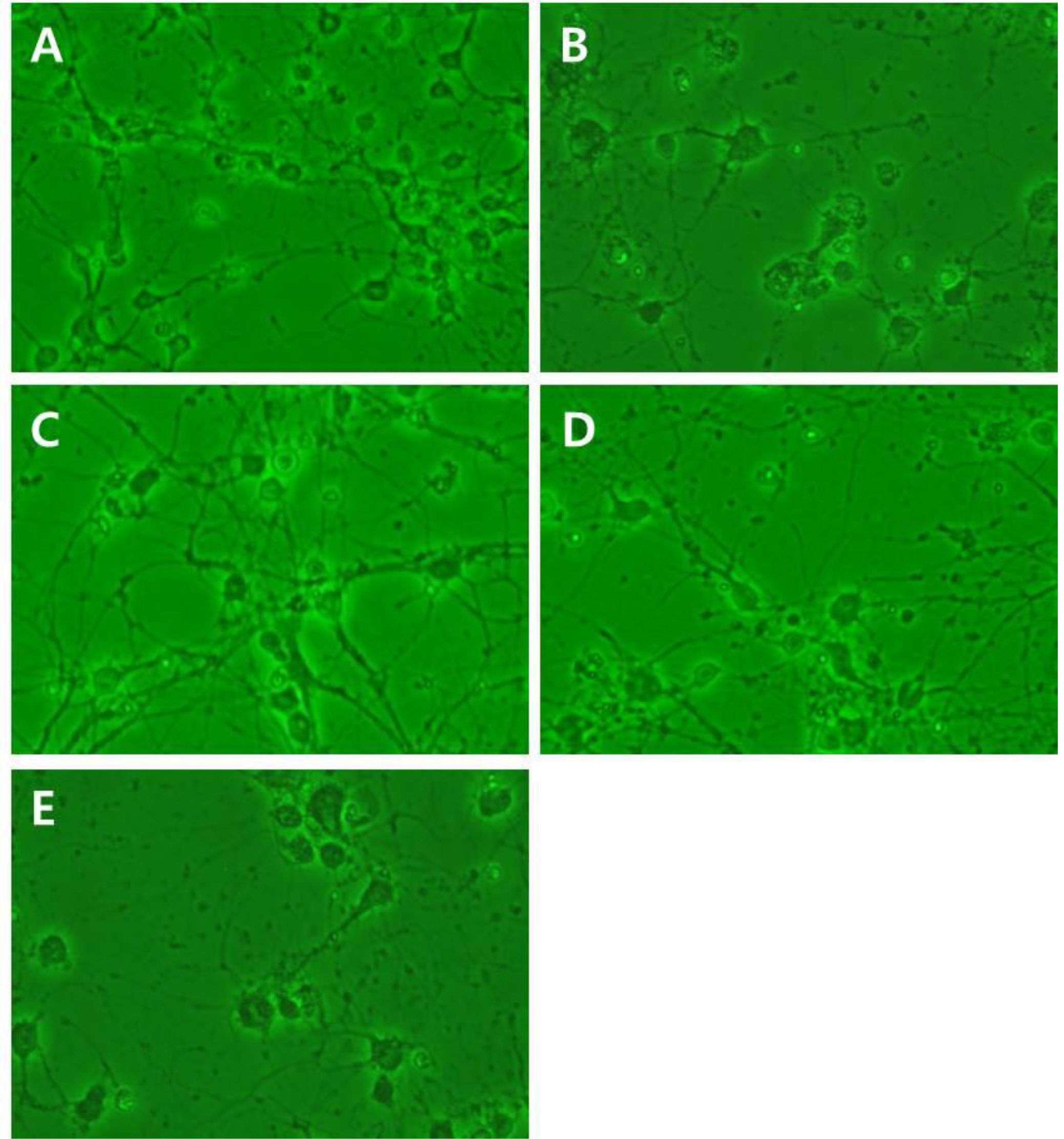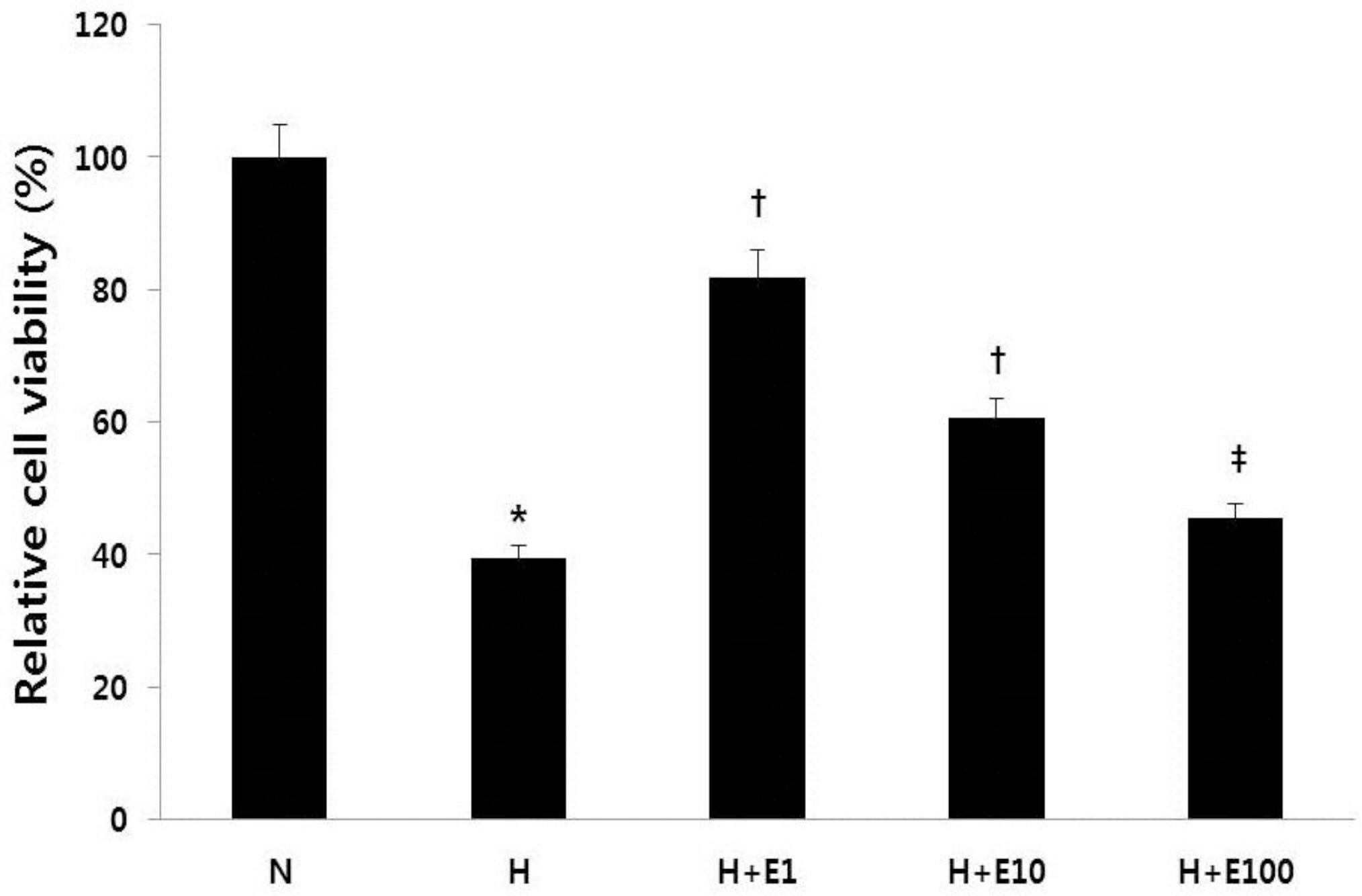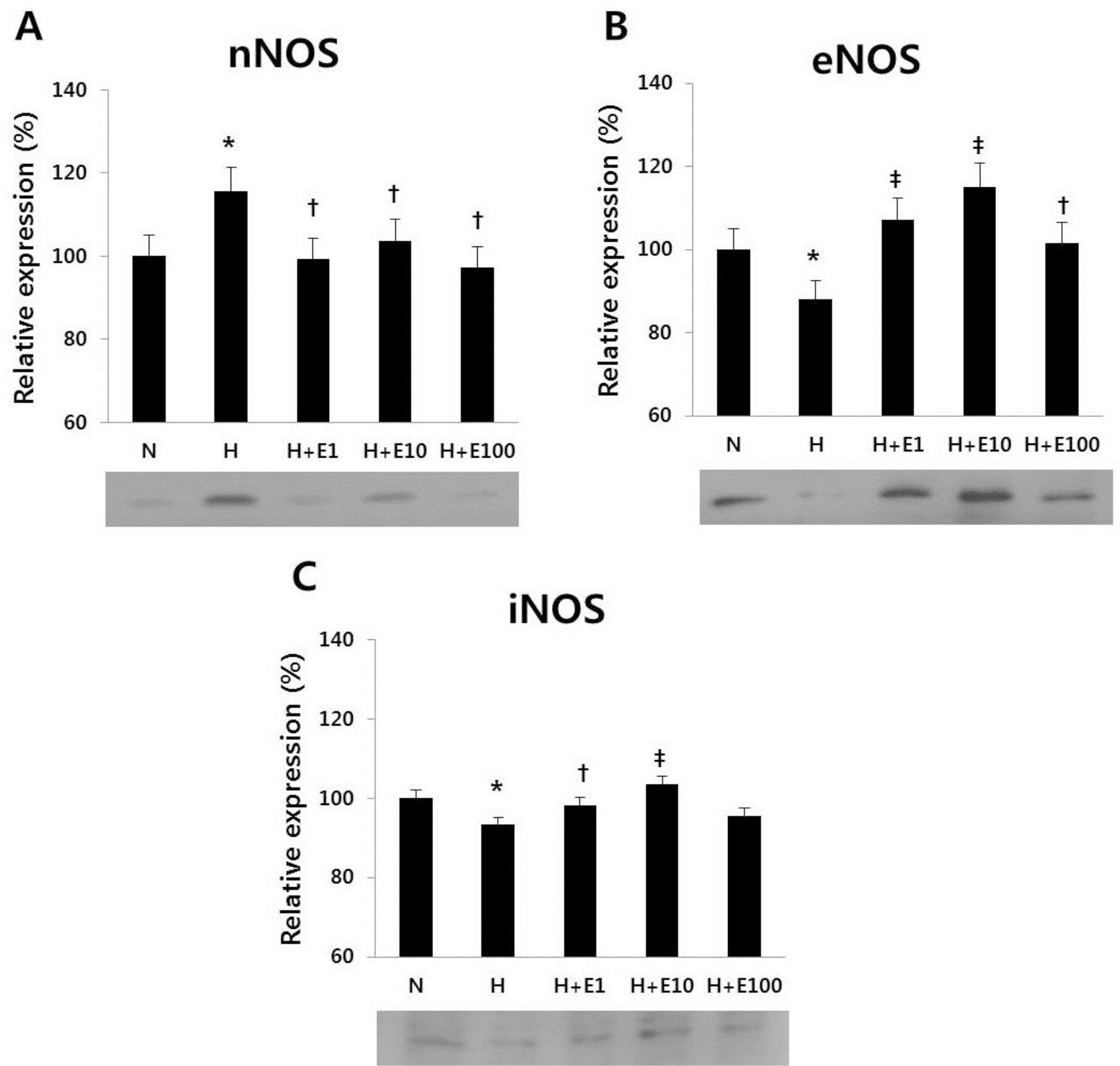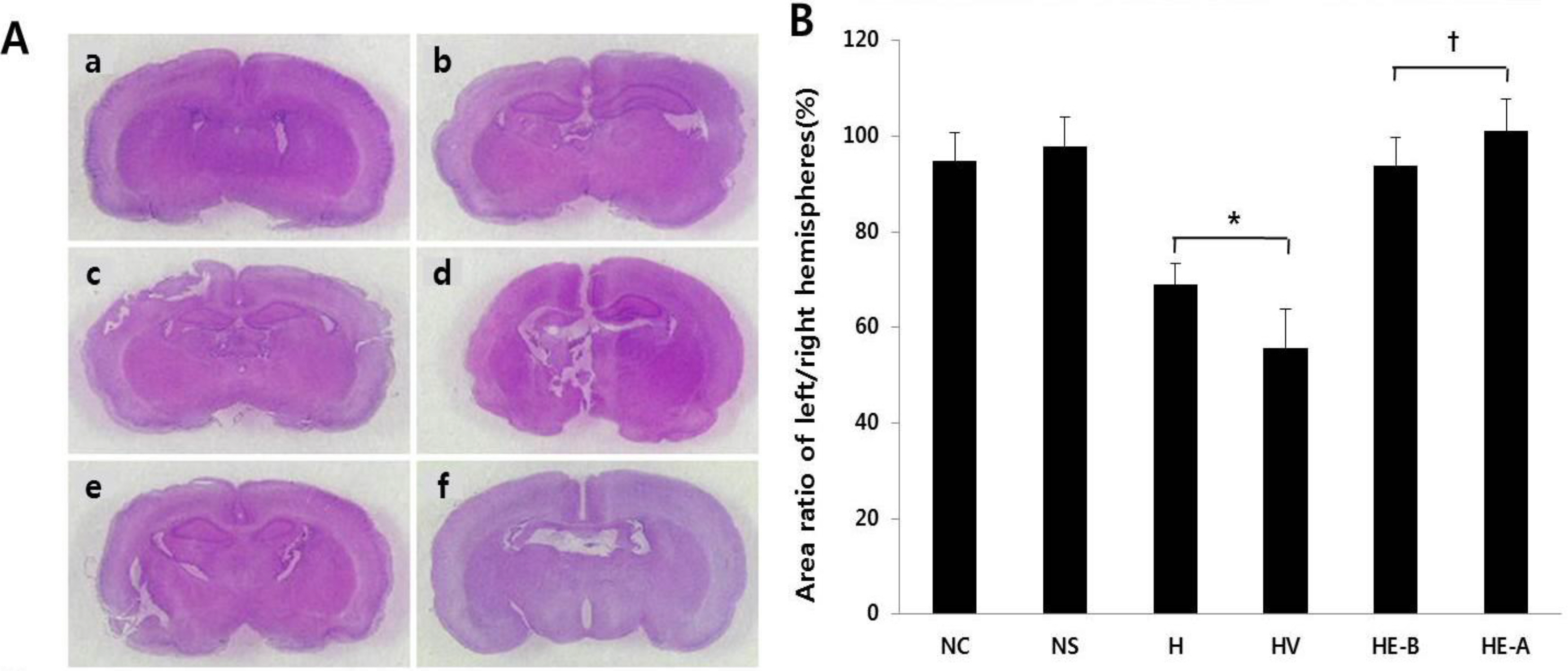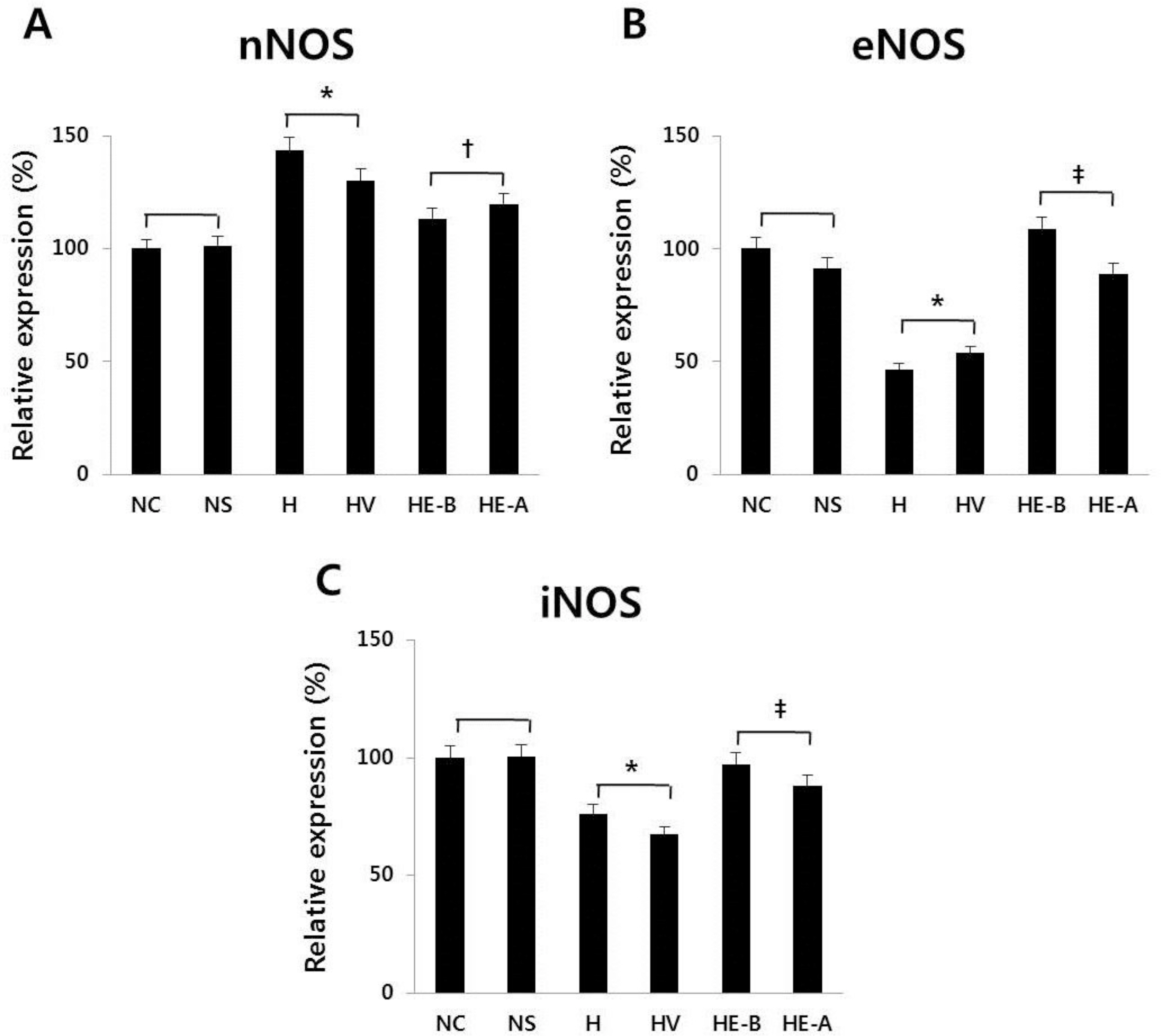Perinatology.
2017 Sep;28(3):79-91. 10.14734/PN.2017.28.3.79.
Recombinant Human Erythropoietin Exerts Neuroprotective Effects via Modulation of Nitric Oxide Synthase on Hypoxic-Ischemic Brain Injury in Neonatal Rats
- Affiliations
-
- 1Department of Pediatrics, Catholic University of Daegu School of Medicine, Daegu, Korea. wootykim@hanmail.net
- 2Department of Pediatrics, Kyungpook National University School of Medicine, Daegu, Korea.
- KMID: 2392428
- DOI: http://doi.org/10.14734/PN.2017.28.3.79
Abstract
OBJECTIVE
Erythropoietin (EPO) has neuroprotective effects in many animal models of brain injury including hypoxic-ischemic (HI) encephalopathy, trauma- and excitotoxicity. Current studies have demonstrated the neuroprotective effects of EPO, but there are limited the same consequences occurring during neonatal periods. Here, we investigated whether recombinant human EPO (rHuEPO) can protect the developing rat brain from HI injury via the modulation of nitric oxide synthase.
METHODS
The in vitro model involved culturing embryonic cortical neuronal cells of Sprague-Dawley (SD) rats at 19 days gestation. The cultured cells were divided into five groups: normoxia (N), hypoxia (H), 1, 10 and 100 IU/mL rHuEPO-treated (H+E1, H+E10, and H+E100). In the in vivo model, left carotid artery ligation was performed in 7-day-old SD rat pups. The animals were divided into six groups: normoxia control, normoxia Sham-operated, hypoxia only (H), hypoxia+vehicle, hypoxia+ rHuEPO before a hypoxic insult (HE-B), and hypoxia+rHuEPO after a hypoxic insult (HE-A). Western blotting and real-time polymerase chain reaction using antibodies and primers of inducible NOS (iNOS), endothelial NOS (eNOS) and neuronal NOS (nNOS) were performed.
RESULTS
The rHuEPO-treated group in the in vitro model showed increased expressions of iNOS and eNOS and decreased expression of nNOS compared to those of the H group. In the HE-A and HE-B groups of the in vivo model of the, the results were similar as aforementioned.
CONCLUSION
rHuEPO exerts neuroprotective properties over perinatal HI brain injuries through the modulation of nitric oxide synthase.
Keyword
MeSH Terms
-
Animals
Anoxia
Antibodies
Blotting, Western
Brain Diseases
Brain Injuries*
Brain*
Carotid Arteries
Cells, Cultured
Erythropoietin*
Humans*
In Vitro Techniques
Ligation
Models, Animal
Neurons
Neuroprotective Agents*
Nitric Oxide Synthase*
Nitric Oxide*
Pregnancy
Rats*
Rats, Sprague-Dawley
Real-Time Polymerase Chain Reaction
Antibodies
Erythropoietin
Neuroprotective Agents
Nitric Oxide
Nitric Oxide Synthase
Figure
Reference
-
1). Higuchi Y., Hattori H., Kume T., Tsuji M., Akaike A., Furusho K. Increase in nitric oxide in the hypoxic-ischemic neonatal rat brain and suppression by 7-nitroindazole and aminoguanidine. Eur J Pharmacol. 1998. 342:47–9.
Article2). Ishida A., Trescher WH., Lange MS., Johnston MV. Prolonged suppression of brain nitric oxide synthase activity by 7-nitroindazole protects against cerebral hypoxic-ischemic injury in neonatal rat. Brain Dev. 2001. 23:349–54.
Article3). Kumral A., Baskin H., Gokmen N., Yilmaz O., Genc K., Genc S, et al. Selective inhibition of nitric oxide in hypoxic-ischemic brain model in newborn rats: is it an explanation for the protective role of erythropoietin? Biol Neonate. 2004. 85:51–4.
Article4). Niwa M., Inao S., Takayasu M., Kawai T., Kajita Y., Nihashi T, et al. Time course of expression of three nitric oxide synthase isoforms after transient middle cerebral artery occlusion in rats. Neurol Med Chir (Tokyo). 2001. 41:63–72. discussion 72-3.
Article5). Zhang ZG., Chopp M., Zaloga C., Pollock JS., Förstermann U. Cerebral endothelial nitric oxide synthase expression after focal cerebral ischemia in rats. Stroke. 1993. 24:2016–21. discussion 2021-2.
Article6). Samdani AF., Dawson TM., Dawson VL. Nitric oxide synthase in models of focal ischemia. Stroke. 1997. 28:1283–8.
Article7). Ishida A., Ishiwa S., Trescher WH., Nakajima W., Lange MS., Blue ME, et al. Delayed increase in neuronal nitric oxide synthase immunoreactivity in thalamus and other brain regions after hypoxic-ischemic injury in neonatal rats. Exp Neurol. 2001. 168:323–33.
Article8). Garcia-Bonilla L., Moore JM., Racchumi G., Zhou P., Butler JM., Iadecola C, et al. Inducible nitric oxide synthase in neutrophils and endothelium contributes to ischemic brain injury in mice. J Immunol. 2014. 193:2531–7.
Article9). Voituron N., Jeton F., Cholley Y., Hasnaoui-Saadani RE., Marchant D., Quidu P, et al. Catalyzing role of erythropoietin on the nitric oxide central pathway during the ventilatory responses to hypoxia. Physiol Rep. 2014. 2:e00223.
Article10). Calapai G., Marciano MC., Corica F., Allegra A., Parisi A., Frisina N, et al. Erythropoietin protects against brain ischemic injury by inhibition of nitric oxide formation. Eur J Pharmacol. 2000. 401:349–56.
Article11). Lombardero M., Kovacs K., Scheithauer BW. Erythropoietin: a hormone with multiple functions. Pathobiology. 2011. 78:41–53.
Article12). Rangarajan V., Juul SE. Erythropoietin: emerging role of erythropoietin in neonatal neuroprotection. Pediatr Neurol. 2014. 51:481–8.
Article13). Sakanaka M., Wen TC., Matsuda S., Masuda S., Morishita E., Nagao M, et al. In vivo evidence that erythropoietin protects neurons from ischemic damage. Proc Nat Acad Sci U S A. 1998. 95:4635–40.
Article14). Gonzalez FF., Larpthaveesarp A., McQuillen P., Derugin N., Wendland M., Spadafora R, et al. Erythropoietin increases neurogenesis and oligoden-drogliosis of subventricular zone precursor cells after neonatal stroke. Stroke. 2013. 44:753–8.
Article15). Iwai M., Cao G., Yin W., Stetler RA., Liu J., Chen J. Erythropoietin promotes neuronal replacement through revascularization and neurogenesis after neonatal hypoxia/ischemia in rats. Stroke. 2007. 38:2795–803.
Article16). Elmahdy H., El-Mashad AR., El-Bahrawy H., El-Gohary T., El-Barbary A., Aly H. Human recombinant erythropoietin in asphyxia neonatorum: pilot trial. Pediatrics. 2010. 125:e1135–42.
Article17). Wu YW., Bauer LA., Ballard RA., Ferriero DM., Glidden DV., Mayock DE, et al. Erythropoietin for neuroprotection in neonatal encephalopathy: safety and pharmacokinetics. Pediatrics. 2012. 130:683–91.
Article18). Fan X., van Bel F., van der Kooij MA., Heijnen CJ., Groenendaal F. Hypothermia and erythropoietin for neuroprotection after neonatal brain damage. Pediatr Res. 2013. 73:18–23.
Article19). Maiese K., Chong ZZ., Hou J., Shang YC. Erythropoietin and oxidative stress. Curr Neurovasc Res. 2008. 5:125–42.
Article20). Brewer GJ. Isolation and culture of adult rat hippocampal neurons. J Neurosci Methods. 1997. 71:143–55.
Article21). Genc K., Genc S., Baskin H., Semin I. Erythropoietin decreases cytotoxicity and nitric oxide formation induced by inflammatory stimuli in rat oligo-dendrocytes. Physiol Res. 2006. 55:33–8.
Article22). Mosmann T. Rapid colorimetric assay for cellular growth and survival: application to proliferation and cytotoxicity assays. J Immunol Methods. 1983. 65:55–63.
Article23). Rice JE 3rd., Vannucci RC., Brierley JB. The influence of immaturity on hypoxic-ischemic brain damage in the rat. Ann Neurol. 1981. 9:131–41.
Article24). Kumral A., Ozer E., Yilmaz O., Akhisaroglu M., Gokmen N., Duman N, et al. Neuroprotective effect of erythropoietin on hypoxic-ischemic brain injury in neonatal rats. Biol Neonate. 2003. 83:224–8.
Article25). Digicaylioglu M., Lipton SA. Erythropoietin-mediated neuroprotection involves cross-talk between Jak2 and NF-kappaB signalling cascades. Nature. 2001. 412:641–7.26). Ioroi T., Yonetani M., Nakamura H. Effects of hypoxia and reoxygenation on nitric oxide production and cerebral blood flow in developing rat striatum. Pediatr Res. 1998. 43:733–7.
Article27). Zhang ZG., Chopp M., Gautam S., Zaloga C., Zhang RL., Schmidt HH, et al. Upregulation of neuronal nitric oxide synthase and mRNA, and selective sparing of nitric oxide synthase-containing neurons after focal cerebral ischemia in rat. Brain Res. 1994. 654:85–95.28). Huang PL. Nitric oxide and cerebral ischemic preconditioning. Cell Calcium. 2004. 36:323–9.
Article29). De Pascali F., Hemann C., Samons K., Chen CA., Zweier JL. Hypoxia and reoxygenation induce endothelial nitric oxide synthase uncoupling in endothelial cells through tetrahydrobiopterin depletion and S-gluta-thionylation. Biochemistry. 2014. 53:3679–88.
Article30). Ferriero DM., Holtzman DM., Black SM., Sheldon RA. Neonatal mice lacking neuronal nitric oxide synthase are less vulnerable to hypoxic-ischemic injury. Neurobiol Dis. 1996. 3:64–71.
Article31). Iadecola C., Zhang F., Xu S., Casey R., Ross ME. Inducible nitric oxide synthase gene expression in brain following cerebral ischemia. JCereb Blood Flow Metab. 1995. 15:378–84.
Article32). Morishita E., Masuda S., Nagao M., Yasuda Y., Sasaki R. Erythropoietin receptor is expressed in rat hippocampal and cerebral cortical neurons, and erythropoietin prevents in vitro glutamate-induced neuronal death. Neuroscience. 1997. 76:105–16.
Article33). Yu X., Shacka JJ., Eells JB., Suarez-Quian C., Przygodzki RM., Beleslin-Cokic B, et al. Erythropoietin receptor signalling is required for normal brain development. Development. 2002. 129:505–16.
Article34). Reitmeir R., Kilic E., Kilic U., Bacigaluppi M., ElAli A., Salani G, et al. Post-acute delivery of erythropoietin induces stroke recovery by promoting perilesional tissue remodelling and contralesional pyramidal tract plasticity. Brain. 2011. 134(Pt 1):84–99.
Article35). Xiong Y., Mahmood A., Qu C., Kazmi H., Zhang ZG., Noguchi CT, et al. Erythropoietin improves histological and functional outcomes after traumatic brain injury in mice in the absence of the neural erythropoietin receptor. J Neurotrauma. 2010. 27:205–15.
Article36). Iwai M., Stetler RA., Xing J., Hu X., Gao Y., Zhang W, et al. Enhanced oligo-dendrogenesis and recovery of neurological function by erythropoietin after neonatal hypoxic/ischemic brain injury. Stroke. 2010. 41:1032–7.
Article37). Zhu C., Kang W., Xu F., Cheng X., Zhang Z., Jia L, et al. Erythropoietin improved neurologic outcomes in newborns with hypoxic-ischemic en-cephalopathy. Pediatrics. 2009. 124:e218–26.
Article38). Dawson DA. Nitric oxide and focal cerebral ischemia: multiplicity of actions and diverse outcome. Cerebrovasc Brain Metab Rev. 1994. 6:299–324.39). Iadecola C. Bright and dark sides of nitric oxide in ischemic brain injury. Trends Neurosci. 1997. 20:132–9.
Article
- Full Text Links
- Actions
-
Cited
- CITED
-
- Close
- Share
- Similar articles
-
- Neuroprotective Effects of Dizocilpine (MK-801) Via Mediation of Nitric Oxide Synthase on Hypoxic-ischemic Brain Injury in Neonatal Rats
- Expression of nitric oxide synthase isoforms and N-methyl-D-aspartate receptor subunits according to transforming growth factor-beta1 administration after hypoxic-ischemic brain injury in neonatal rats
- Neuroprotective Effects of Taurine Via Modulation of Nitric Oxide Synthase on Hypoxic-Ischemic Brain Injury in Neonatal Rats
- The Neuroprotective Effects of 6-cyano-7-nitroquinoxalin-2,3-dione (CNQX) Via Mediation of Nitric Oxide Synthase on Hypoxic-ischemic Brain Injury in Neonatal Rats
- The neuroprotective effect of recombinant human erythropoietin via an antiapoptotic mechanism on hypoxic-ischemic brain injury in neonatal rats

